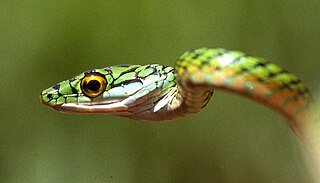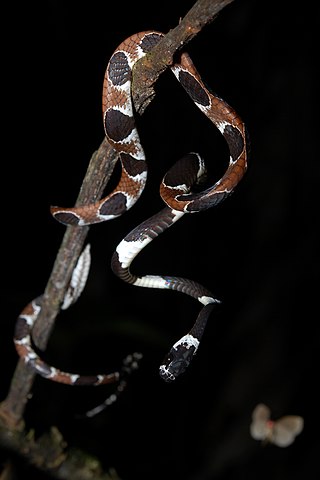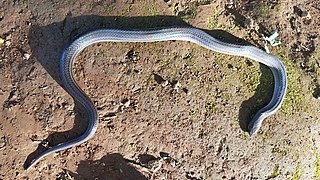
Coral snakes are a large group of elapid snakes that can be divided into two distinct groups, the Old World coral snakes and New World coral snakes. There are 27 species of Old World coral snakes, in three genera, and 83 recognized species of New World coral snakes, in two genera. Genetic studies have found that the most basal lineages have origins in Asia, suggesting that the group originated in the Old World. While new world species of both genera are venomous, their bites are seldom lethal; only two confirmed fatalities have been documented in the past 100 years from the genus Micrurus. Meanwhile, snakes of the genus Micruroides have never caused a medically significant bite.

Micrurus is a genus of venomous coral snakes of the family Elapidae.

Boiga is a large genus of rear-fanged, mildly venomous snakes, known commonly as cat-eyed snakes or simply cat snakes, in the family Colubridae. Species of the genus Boiga are native to southeast Asia, India, and Australia, but due to their extremely hardy nature and adaptability, have spread to many other suitable habitats around the world. There are 38 recognized species in the genus. According to the study done by Jiří Smíd regarding Old World cat snakes, the ancestor of the cat snake originated in Africa, from where it diversified and expanded to other countries. Despite this diversity however, the different species have very similar needs in terms of temperature and precipitation.

Pseudoboa neuwiedii, commonly known as the dark-headed red false boa or Neuwied's false boa, is a species of snake in the family Colubridae. The species is endemic to northern South America.

Oxyrhopus petolarius, commonly known as the forest flame snake, is a species of mildly venomous snake in the family Colubridae. The species is endemic to Central and South America. There are three recognized subspecies.
Lystrophis is the genus of tricolored South American hognose snakes. They mimic milk snakes or coral snakes with their red, black, and white ringed patterns.

Sibynophis is a genus of nonvenomous colubrid snakes, commonly called many-toothed snakes, which together with Scaphiodontophis make up the subfamily Sibynophiinae.

Calamaria is a large genus of dwarf burrowing snakes of the family Colubridae. The genus contains 66 recognized species. The genus is endemic to Asia.

Leptophis is a genus of colubrid snakes, commonly known as parrot snakes. The species within this genus are widely distributed throughout Mexico, Central and South America.

Dipsas is a genus of nonvenomous New World snakes in the subfamily Dipsadinae of the family Colubridae. The genus Sibynomorphus has been moved here. Species of the genus Dipsas are known as snail-eaters.

Oxyrhopus melanogenys, commonly known as Tschudi's false coral snake, is a colubrid snake species found in the northern part of South America.

Dromicodryas is a genus of pseudoxyrophiid snakes found only on the island of Madagascar. They are harmless to humans.

Xenodon is a genus of New World snakes in the subfamily Dipsadinae of the family Colubridae.

Pseudoboa, the false boas, is a genus of snakes in the family Colubridae. The genus is endemic to South America.

Uromacer is a genus of snakes in the family Colubridae endemic to the island of Hispaniola.

Stenorrhina is a genus of snakes in the family Colubridae.
Stegonotus is a genus of snakes in the family Colubridae. Species of the genus Stegonotus are native to Australia, Indonesia, and New Guinea.

Phalotris is a genus of snakes of the subfamily Dipsadinae. All species of the genus Phalotris are found in South America. The specific name, mertensi, is in honor of German herpetologist Robert Mertens. The specific name, normanscotti, is in honor of Norman Scott, Jr., in recognition of his contribution to the knowledge of the herpetofauna of Paraguay.
Tretanorhinus is a genus of snakes in the subfamily Dipsadinae of the family Colubridae.















